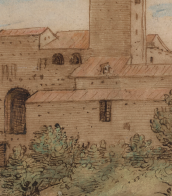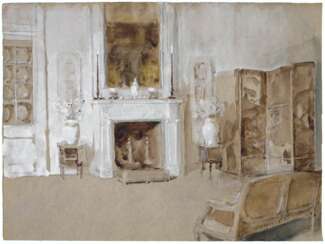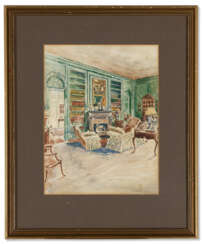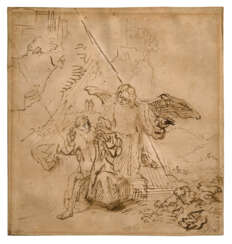walter gay (1856 - 1937)
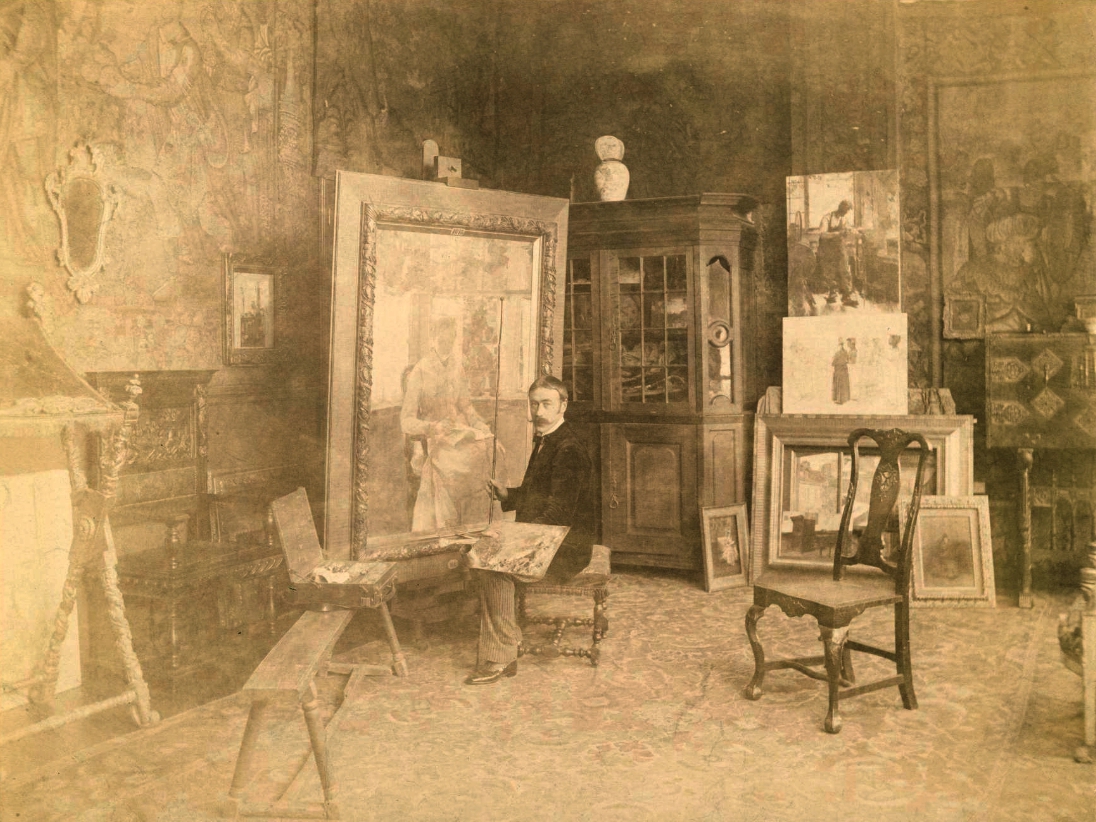
Walter Gay was an American artist known for his elegant, understated paintings of interiors and still lifes. He was studied at the School of the Museum of Fine Arts in Boston before traveling to Paris to continue his education at the Académie Julian.
Gay was part of a group of American artists who were drawn to Paris in the late 19th century, and he became associated with the expatriate community of American and British artists who settled in the city's Montparnasse district.
Gay's paintings are characterized by their subtle color harmonies, refined composition, and attention to detail. He specialized in depicting elegant, tastefully appointed interiors, often featuring antique furniture, works of art, and architectural details. He was also known for his still lifes, which included simple arrangements of flowers, fruit, and other objects arranged on tabletops or in windowsills.
Gay's work was highly sought after by collectors during his lifetime, and he exhibited regularly in Paris, London, and New York. He was awarded the Legion of Honor by the French government in 1908 in recognition of his contributions to the arts. Today, his paintings can be found in the collections of museums around the world, including the Metropolitan Museum of Art in New York and the Musée d'Orsay in Paris.
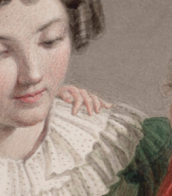

Walter Gay was an American artist known for his elegant, understated paintings of interiors and still lifes. He was studied at the School of the Museum of Fine Arts in Boston before traveling to Paris to continue his education at the Académie Julian.
Gay was part of a group of American artists who were drawn to Paris in the late 19th century, and he became associated with the expatriate community of American and British artists who settled in the city's Montparnasse district.
Gay's paintings are characterized by their subtle color harmonies, refined composition, and attention to detail. He specialized in depicting elegant, tastefully appointed interiors, often featuring antique furniture, works of art, and architectural details. He was also known for his still lifes, which included simple arrangements of flowers, fruit, and other objects arranged on tabletops or in windowsills.
Gay's work was highly sought after by collectors during his lifetime, and he exhibited regularly in Paris, London, and New York. He was awarded the Legion of Honor by the French government in 1908 in recognition of his contributions to the arts. Today, his paintings can be found in the collections of museums around the world, including the Metropolitan Museum of Art in New York and the Musée d'Orsay in Paris.


Walter Gay was an American artist known for his elegant, understated paintings of interiors and still lifes. He was studied at the School of the Museum of Fine Arts in Boston before traveling to Paris to continue his education at the Académie Julian.
Gay was part of a group of American artists who were drawn to Paris in the late 19th century, and he became associated with the expatriate community of American and British artists who settled in the city's Montparnasse district.
Gay's paintings are characterized by their subtle color harmonies, refined composition, and attention to detail. He specialized in depicting elegant, tastefully appointed interiors, often featuring antique furniture, works of art, and architectural details. He was also known for his still lifes, which included simple arrangements of flowers, fruit, and other objects arranged on tabletops or in windowsills.
Gay's work was highly sought after by collectors during his lifetime, and he exhibited regularly in Paris, London, and New York. He was awarded the Legion of Honor by the French government in 1908 in recognition of his contributions to the arts. Today, his paintings can be found in the collections of museums around the world, including the Metropolitan Museum of Art in New York and the Musée d'Orsay in Paris.
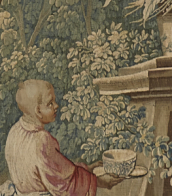

Walter Gay was an American artist known for his elegant, understated paintings of interiors and still lifes. He was studied at the School of the Museum of Fine Arts in Boston before traveling to Paris to continue his education at the Académie Julian.
Gay was part of a group of American artists who were drawn to Paris in the late 19th century, and he became associated with the expatriate community of American and British artists who settled in the city's Montparnasse district.
Gay's paintings are characterized by their subtle color harmonies, refined composition, and attention to detail. He specialized in depicting elegant, tastefully appointed interiors, often featuring antique furniture, works of art, and architectural details. He was also known for his still lifes, which included simple arrangements of flowers, fruit, and other objects arranged on tabletops or in windowsills.
Gay's work was highly sought after by collectors during his lifetime, and he exhibited regularly in Paris, London, and New York. He was awarded the Legion of Honor by the French government in 1908 in recognition of his contributions to the arts. Today, his paintings can be found in the collections of museums around the world, including the Metropolitan Museum of Art in New York and the Musée d'Orsay in Paris.
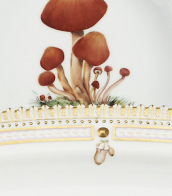

Rembrandt Harmenszoon van Rijn, a Dutch Baroque painter and printmaker, was born on July 15, 1606, in Leiden, Netherlands, and died on October 4, 1669, in Amsterdam. He is celebrated as one of the greatest storytellers in art history, acclaimed for his adept portrayal of human emotions and dramatic narratives. Rembrandt's extensive oeuvre includes portraits, self-portraits, landscapes, genre scenes, allegorical, historical, and biblical themes, as well as animal studies. His artistry shined during the Dutch Golden Age, a period marked by cultural and scientific achievements in the Netherlands.
Rembrandt's education in art began around the age of 10 when he left the Latin School in Leiden to train as an artist. He apprenticed with artists like Jacob van Swanenburg and Pieter Lastman, mastering various aspects of painting. He opened his own studio in Leiden around 1624 or 1625, sharing it with his colleague Jan Lievens. By 1631, he had moved to Amsterdam, where he achieved significant success and trained many important Dutch painters.
Among Rembrandt's notable works are "The Anatomy Lesson of Dr. Nicolaes Tulp" (1632), "The Night Watch" (1642), and "The Syndics of the Amsterdam Drapers’ Guild" (1662). He was also renowned for his self-portraits, creating around 80 over his lifetime, more than any other artist until the 20th century. These self-portraits were not just artistic endeavors but also experiments with facial expressions and lighting effects. Additionally, Rembrandt was a master etcher, transforming etching from a reproductive technique into an art form.
Rembrandt's painting style is characterized by its dramatic use of light and shadow, known as chiaroscuro. His ability to depict materials realistically was unparalleled; his portrayal of metals and fabrics was so lifelike that they appeared to glow and be tangible. He was also known for his impasto technique, applying paint thickly to the canvas, adding a three-dimensional quality to his works.
Despite his artistic prowess, Rembrandt faced financial difficulties and personal tragedies throughout his life. He declared bankruptcy in 1656, a downfall attributed partly to his extensive collection of art objects and curiosities. His masterpieces, however, continued to garner appreciation and influence generations of artists that followed.
For collectors and experts in art and antiques, Rembrandt's works represent a pinnacle of artistic achievement in the Dutch Golden Age. His mastery in portraying the human condition and his innovative techniques in painting and etching make his works highly prized and influential in the art world.
To stay updated on new product sales and auction events related to Rembrandt van Rijn, sign up for our updates. This subscription service is dedicated exclusively to news and events concerning works related to this unparalleled master of the Dutch Golden Age.
